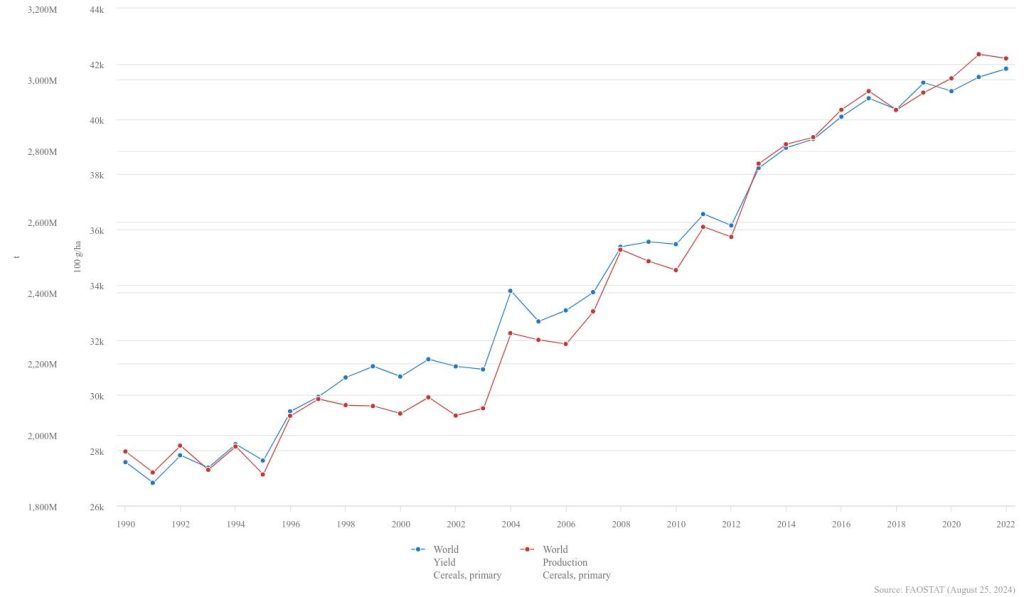Human Progress excerpted a paywalled article from Bloomberg discussing the fact that major crops are expected to continue to set records in the 2024/2025 crop year. This good news is not unexpected for anyone who understands agronomy and botany or who regularly reads Climate Realism. It reflects the long-term trend for most crops during the period of modest warming and increased atmospheric carbon dioxide (CO2) concentrations. Sadly, Bloomberg’s story ignores the proven and significant role rising CO2 levels are playing in improved crop yields and production.
Human Progress writes:
Compared with a decade ago, the world will harvest in 2024-25 about 10% more wheat, about 15% more corn, nearly 30% more soybeans, and about 10% more rice. Except for corn, all the other three key food commodities will enjoy a record high production.
[T]he US Department of Agriculture said it anticipates American farmers will reap record yields for two key food commodities: on average, 183.1 bushels per acre of corn, and 53.2 bushels per acre of soybeans…
Two decades ago, US corn farmers were harvesting about 150 bushels per acre; in the mid-1980s, the number was closer to 110 bushels.
This good news further confirms what Climate Realism has long pointed out. Modestly warmer weather and higher CO2 levels are good for plants in general, leading to a net greening of the earth and boosting yields and production of crops. In fact, the most recent data from the U.N. Food and Agriculture Organization (FAO) show that globally the yield and production of cereal crops (the crop segment that makes up the majority of the calorie intake each day, often referred to as staple foods, rice, wheat, rye, oats, barley, millet, and maize, for example), have increased dramatically over the recent period slight warming. Between 1990 and 2022, the most recent year for which the FAO has data:
- Cereal yields have increased nearly 52 percent, with the most recent record for yield set in 2022; and
- Cereal production grew by approximately 57 percent. (see the chart, below)

Unfortunately, Bloomberg downplays or ignores entirely the role warming and rising CO2 have played in record crop yields and production, attributing the record setting crop production to expanded irrigation and better technologies like improved combines and tractors. Although improved technologies and wider access to them has undoubtedly contributed to the increase in crop production, research thoroughly demonstrates that so to have CO2 increases. Indeed, higher CO2 levels may have been the most significant factor driving crop increases in recent decades.
As has been discussed in more than 200 articles on Climate Realism, what is true of global cereal production, is true for most crops, like fruits, legumes, tubers, and vegetables, in most countries around the world. Yields have set records repeatedly during the recent period of climate change, food security has increased, and hunger and malnutrition have fallen.
Agronomy and Botany explain why crop production and yields have increased amidst global warming, and the same sciences explain why the world should likely expect crop production gains to continue. Modest warming has brought slightly higher rainfall totals, and a modestly longer growing season with fewer crop-killing late-season frosts. In addition, crops are benefitting from higher carbon dioxide levels in the atmosphere, which any greenhouse operator will tell you is plant fertilizer, contributing to plants growing larger, faster, and using water more efficiently.
Thousands of real-world field and greenhouse experiments summarized at CO2 Science document the beneficial effect on higher CO2 concentrations on plant growth and crop production. Even NASA has acknowledged this point, writing:
Studies have shown that higher concentrations of atmospheric carbon dioxide affect crops in two important ways: they boost crop yields by increasing the rate of photosynthesis, which spurs growth, and they reduce the amount of water crops lose through transpiration. Plants transpire through their leaves, which contain tiny pores called stomata that open and collect carbon dioxide molecules for photosynthesis. During that process they release water vapor. As carbon dioxide concentrations increase, the pores don’t open as wide, resulting in lower levels of transpiration by plants and thus increased water-use efficiency.
Specifically, research cited in the journal Environmental Economics and Policy Studies found:
[S]atellite-based studies have yielded compelling evidence of stronger general growth effects than were anticipated in the 1990s. Zhu et al (2016) published a comprehensive study on greening and human activity from 1982 to 2009. The ratio of land areas that became greener, as opposed to browner, was approximately 9 to 1. The increase in atmospheric CO2 was just under 15% over the interval but was found to be responsible for approximately 70% of the observed greening, followed by the deposition of airborne nitrogen compounds (9%) from the combustion of coal and deflation of nitrate-containing agricultural fertilizers, lengthening growing seasons (8%), and land cover changes (4%), mainly reforestation of regions such as southeastern North America.
It is refreshing to see a major media outlet, like Bloomberg, publish some good news about crop production amid the near constant drum beat of false “climate change induced crop failure” stories put out by the mainstream media. One can only speculate why its writers ignored the firmly established roles that modest warming and more CO2 have played over the decades and continue to play in the increase in food production.


















